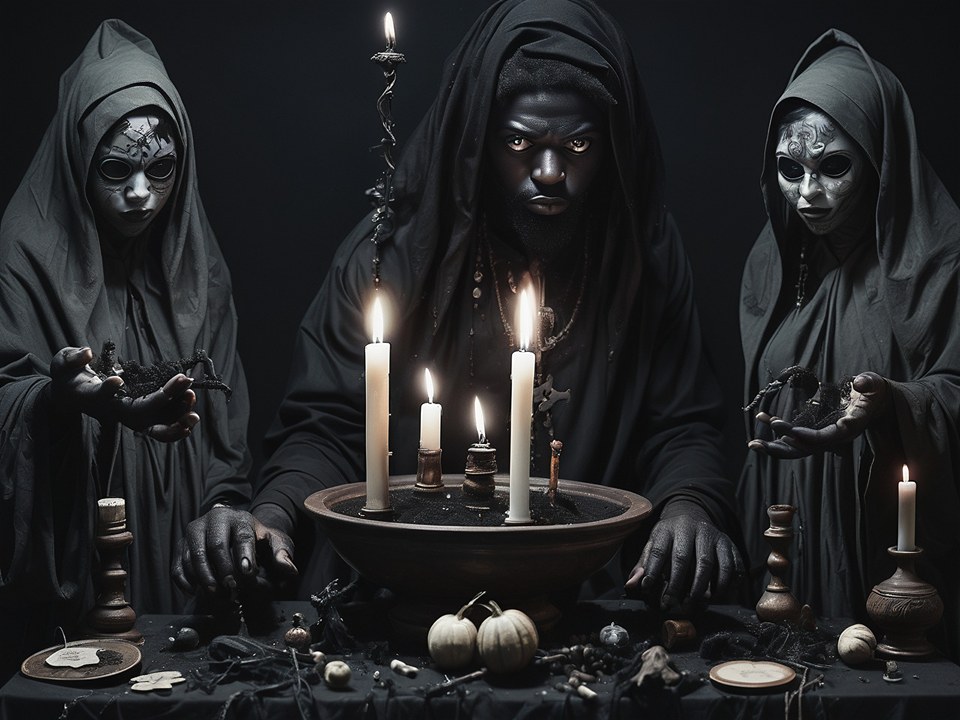In the journey of life, career decisions hold immense significance. Choosing the right path can lead to fulfilment, prosperity, and success. However, the quest for a rewarding career can be daunting, filled with uncertainties and challenges. This is where astrology comes into play, offering guidance and insights to help individuals make informed career choices. Sri Bhairav Mantrik Astrologer specializes in providing career-oriented astrological consultations, helping individuals align their professional lives with their innate strengths and aspirations.
Introduction
Black magic—a term that often evokes a mixture of fear, intrigue, and mystery within the cultural fabric of India. Traditionally associated with the supernatural elements of the dark arts, black magic refers to the use of magical practices to harm or manipulate others’ will to the caster’s advantage. In India, where spirituality and superstition intertwine, black magic holds a significant and complex place in the collective psyche.
This ancient practice is deeply rooted in the country’s folklore and has been both revered and reviled throughout Indian history. From the tales whispered in hushed tones across rural firesides to the more urban myths recounted with a skeptical laugh, black magic remains a topic of continuous fascination. Through this blog post, we aim to demystify the enigmatic world of black magic, tracing its origins, understanding its methods, and exploring its impact on Indian society. By shedding light on these shadowy practices, we invite you to look beyond the myths and understand the real influence of black magic in the cultural and astrological contexts of India.

Historical Context of Black Magic in India
The practice of black magic in India can be traced back to ancient times, deeply woven into the fabric of Hindu mythology and folklore. Historical texts, like the Atharva Veda, one of the four sacred texts of Hinduism, contain hymns that address the use of spells for healing as well as for cursing enemies—a testament to the dual nature of such practices. In medieval India, tales of sorcerers and practitioners known as ‘tantriks’ who wielded these arcane powers became commonplace, often serving the dual purpose of healers and harmers.
As Indian civilization progressed, the role of black magic evolved, blending with cultural and regional variations. Each region developed its own version of the craft, influenced by local beliefs and practices. In some communities, it was, and still is, seen as a potent tool against oppression, while in others, it has been a means to consolidate power and control. This duality of black magic has painted it as both a protective art and a weapon, depending on the intent of the user.
Understanding Black Magic: Definition and Practices
Black magic, or ‘Kala Jadu’ as it is commonly known in India, is often defined as the negative use of supernatural powers to influence events, people, or nature in ways that are beyond the ordinary. The practice involves rituals and spells which can vary widely, from simple charms to elaborate ceremonies involving mantras, yantras, and sometimes even sacrificial rites.
Common practices include the creation of talismans or amulets, chanting of mantras, and conducting rituals during specific astrological alignments, believed to enhance the potency of the spells. Ingredients used in these rituals might range from benign substances like herbs and flowers to more controversial items like animal or even human relics, though the latter is rare and highly secretive.
Black magic rituals in India are often sought for personal gain, to settle grudges, or for love and relationships, reflecting deep-seated beliefs in destiny and the power of the unseen forces that can alter it. These practices, while secretive, are an open secret in many parts of the country, with practitioners both feared and respected in their communities.
The Role of Astrology in Black Magic
Astrology and black magic in India are often intertwined, with astrological timings playing a crucial role in the effectiveness of magical rituals. Many believe that certain planetary alignments can enhance or weaken the powers of black magic, making the timing of spells a critical element of the practice. Astrologers and black magic practitioners frequently consult astrological charts to determine auspicious or inauspicious times for their rituals.
Planets like Saturn (Shani) and Rahu are often associated with darker energies and are believed to have strong links to the practice of black magic. When these planets are predominant in someone’s horoscope, it is thought that the individual might be more susceptible to the effects of black magic. Remedial measures, often prescribed by astrologers, include wearing specific gemstones, performing puja (ritual worship), and chanting mantras to ward off the evil effects of black magic.
The integration of astrology with black magic also reflects in the belief that celestial bodies influence one’s fortune and fate. This belief system supports the idea that manipulating these influences through black magic can alter personal outcomes, thereby playing a significant role in the decisions people make, especially during times of distress or conflict.
Cultural Impact and Beliefs
The impact of black magic on Indian culture cannot be overstated, with its influences visible across various aspects of life, including personal relationships, business dealings, and health. In some rural areas, the fear of black magic pervades daily life, influencing everything from agricultural practices to marital choices. Community healers, often known as ‘Baba’ or ‘Tantrik’, are sometimes sought to counteract the effects of black magic, using a mixture of rituals and counter-spells.
Conversely, in urban areas, while modernity has lessened the overt fear of black magic, it still persists subtly. Many educated individuals secretly consult practitioners to improve their fortunes or to hinder adversaries. The practice is so ingrained in the cultural fabric that it often coexists with the technological and rational mindset that characterizes contemporary India.
Regionally, the practice of black magic varies significantly. In West Bengal, for example, the ‘Bangal’ magic is renowned for its intensity, often linked to the fierce goddess Kali. In contrast, in South India, particularly in states like Tamil Nadu and Kerala, the practices involve complex rituals that are an amalgam of Dravidian ancient customs and later Hindu influences.
Conclusion
Black magic in India is a phenomenon that transcends the simple dichotomy of good and evil, weaving itself into the cultural and spiritual tapestry of the nation. While it often carries a negative connotation, it is also sought for protection, healing, and sometimes as a means of last resort by those who feel powerless. The future of black magic in modern India remains uncertain—while some view it as a relic of a superstitious past, others see it as a living part of Indian tradition that continues to adapt to contemporary realities.
As India continues to evolve, the practice of black magic may diminish under the lights of modernity and science, or it may persist, reshaping itself in new forms. Whatever its trajectory, black magic will undoubtedly remain a part of the conversations about culture, ethics, and spirituality in India for years to come.
Frequently Asked Questions
Whether black magic is real or not varies greatly according to personal beliefs and cultural backgrounds. There is no scientific evidence to support the workings of black magic, however, it holds significant meaning in various cultures. For a deeper exploration of this topic, consider reading our detailed blog post here.
Many believe in using protective amulets, performing regular spiritual cleansings, or consulting with spiritual advisors to guard against black magic.
Culturally, using black magic is often viewed as tampering with natural forces and can lead to moral and ethical dilemmas. Many believe that misuse or malicious use of black magic can backfire, bringing misfortune or negative repercussions to the practitioner or those who employ such services.
In cultural contexts where it is practiced, black magic is often sought for personal gain such as improving financial situations, influencing relationships, or achieving success in endeavors where natural efforts are deemed insufficient. It is also occasionally used for protective purposes against various forms of negativity and misfortune.
Protection against black magic can involve the use of amulets, spiritual cleansings, or rituals. Consulting with spiritual or religious advisors who specialize in these practices is common, as they can provide specific protective measures tailored to individual circumstances.
Removal of black magic typically involves complex rituals or prayers, often conducted by experienced practitioners. These rituals may include the use of sacred herbs, specific chants, or purification ceremonies designed to cleanse the individual or space of the negative energies associated with black magic. Read our blog here for detailed information.
Common signs believed to indicate the influence of black magic include unexplained illnesses, severe depression, sudden misfortune, and disturbances in sleep patterns or dreams. These signs are traditionally interpreted as evidence of negative spiritual interference.
Believers in black magic claim that it can work covertly, affecting a person’s life and well-being without their immediate awareness. This is why some people periodically seek spiritual check-ups from knowledgeable practitioners.
Mantras in black magic rituals vary, often tailored to specific goals such as love, revenge, or protection. These mantras are usually recited in specific counts and at designated times to maximize their efficacy. They are considered powerful and are kept secret to prevent misuse.
Physical symptoms of black magic influence can include sudden, severe fatigue, unexplainable aches and pains, and unusual marks on the body. These symptoms are often resistant to conventional medical treatment, leading those affected to seek spiritual remedies. Read our blog here for detailed information.
Check out some blogs that could be useful for you!
Astrology and incantations are two ancient practices that have interwoven into various cultures for centuries. While astrology involves the study of celestial bodies and their influence on human affairs, incantations are spoken words or phrases believed to possess magical power. The question arises: can astrologers use incantations, and if so, how do these two disciplines complement each other? This comprehensive guide explores the synergy between astrology and incantations, delving into historical contexts, practical applications, and their relevance in modern spiritual practices.
Astrology has been an integral part of many cultures, offering insights and guidance through the interpretation of celestial movements. Finding a skilled astrologer can be a transformative experience, providing clarity and support in various aspects of life. In this article, we will explore why Sri Bhairav Mantrik Astrologer stands out as the best astrologer and how you can reach out to them for reliable astrological solutions.


